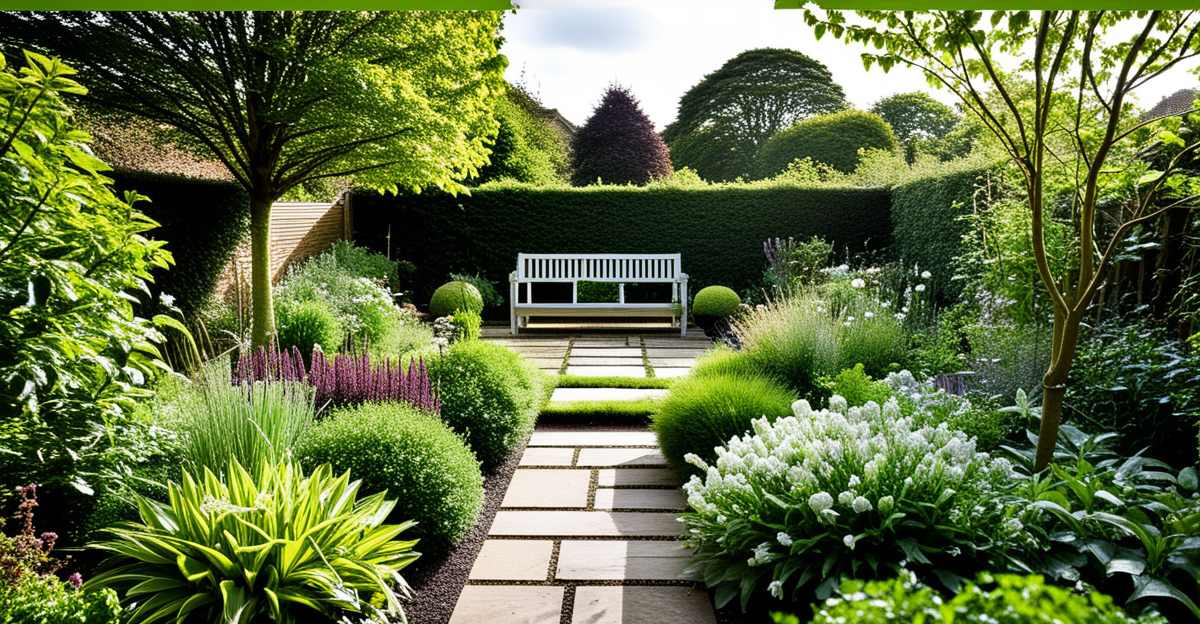Understanding the UK Climate and Its Impact on Garden Design
The UK garden climate is famously variable, influencing every aspect of garden planning. British gardening weather can shift quickly, with frequent rainfall, cool temperatures, and occasional frost impacting plant growth. Garden designers must account for these fluctuations to ensure long-term success.
Regional garden planning starts by analysing local weather patterns. Western areas like Cornwall often experience mild winters and heavy rain, favoring moisture-loving plants. In contrast, East Anglia’s drier conditions require drought-tolerant species. Recognizing these differences helps gardeners select plants that thrive rather than just survive.
Also read : How Can You Transform Urban Apartments into Cozy Homes with Minimal Effort?
Microclimates within your garden can significantly affect plant health. South-facing walls, sheltered corners, or raised beds create warmer or drier spots, ideal for growing tender plants in otherwise cooler climates. Paying attention to these subtleties offers an opportunity to expand plant options and improve overall garden success.
By adapting designs to the unique UK garden climate and understanding microclimates, gardeners can create resilient, vibrant spaces tailored to their local British gardening weather. This approach ensures sustainable growth and reduces plant stress.
Topic to read : How do you choose the perfect indoor plants for a UK home?
Understanding the UK Climate and Its Impact on Garden Design
The UK garden climate is notably variable, with regional differences that significantly influence garden choices. British gardening weather often includes wet winters, mild summers, and frequent rainfall, requiring gardeners to consider moisture-loving plants alongside drought-tolerant species. Understanding these patterns is crucial for effective garden planning across the UK.
Regional garden planning involves acknowledging microclimates within your garden—small areas where conditions such as sun exposure, wind protection, or soil moisture differ from the broader environment. For example, a sheltered corner beside a wall may support plants less hardy than those in open spaces. Evaluating these microclimates allows for more precise plant selection and placement, promoting healthier growth.
Selecting plants that thrive in the varying UK climates means prioritizing species adapted to local conditions. Opting for native or resilient plants reduces maintenance and improves gardening success. Combining plant varieties suited for different regional weather ensures your garden remains vibrant through unpredictable British gardening weather, blending aesthetics with practicality.
Evaluating Soil Types and Preparation
Understanding UK soil types is crucial for successful garden soil preparation. Typical soils vary from heavy clay in clayey regions to sandy soils in coastal areas, with loam providing a balanced texture in many gardens. Each soil type influences water retention and nutrient availability, affecting plant health.
Accurate soil testing is essential to assess soil quality. Testing involves checking pH levels and nutrient content—both vital for selecting appropriate plants and amendments. UK soils often range from acidic to neutral, guiding gardeners on lime addition or acidifying agents needed. Tests can be done using simple kits or through professional services for greater precision.
Effective garden soil preparation transforms your soil’s structure and fertility. Incorporating organic matter like compost improves moisture retention in sandy soils and drainage in clay soils. Mulching helps maintain soil temperature and moisture, reducing stress on plants amid variable British gardening weather. Regular soil assessment and appropriate amendments ensure your garden thrives across changing seasons and regional conditions. This proactive approach optimizes plant growth and resilience in diverse UK environments.
Evaluating Soil Types and Preparation
Understanding UK soil types is essential for successful gardening. Common types include clay, sandy, loamy, and peaty soils, each influencing water drainage and nutrient availability differently. For example, clay soils tend to retain water but can become compacted, whereas sandy soils drain quickly but may require additional nutrients. Recognizing your soil type helps tailor garden soil preparation effectively.
Soil testing provides precise information on nutrient content, pH levels, and structure. Testing often involves collecting samples from various garden areas to measure acidity or alkalinity, vital for selecting appropriate plants. Most UK soils range from slightly acidic to neutral, but some areas with peat or chalk may differ significantly, influencing garden success.
Improving garden soil preparation involves methods such as adding organic matter like compost to enhance fertility and structure or adjusting pH with lime or sulfur. Regular mulching conserves moisture and suppresses weeds, supporting healthier plants. Tailored soil management combined with knowledge of UK soil types ensures vibrant growth and garden longevity.
Choosing Suitable Plants for UK Gardens
Selecting the best plants for UK gardens requires understanding plant adaptability to the UK’s diverse climate zones. Native UK plants often excel because they have evolved to thrive in local conditions, offering resilience against common pests and fluctuating weather. These plants typically require less maintenance and promote biodiversity.
When choosing plants, consider plant hardiness selection carefully. Plant hardiness indicates a species’ ability to withstand the often unpredictable British gardening weather. For example, perennials like hellebores and lavender survive cold winters, while hardy shrubs such as hawthorn adapt well to damp environments. Selecting plants suited to your region’s climate reduces the risk of plant stress and failure.
Combining ornamental species with edible and wildlife-attracting plants enriches your garden’s ecosystem. Native flowers like foxglove support pollinators, while fruiting plants provide food for birds. This mix contributes to a balanced garden that is both beautiful and ecologically supportive. Understanding plant hardiness and the benefits of native species makes plant selection a strategic, rewarding process in UK garden design.
Choosing Suitable Plants for UK Gardens
Selecting the best plants for UK gardens hinges on understanding native species and their adaptability to British gardening weather. Native UK plants have evolved alongside the local climate, making them resilient to fluctuating temperatures and frequent rain. This natural hardiness reduces watering needs and maintenance, ideal for sustainable gardening.
When considering plant hardiness selection, prioritize species with proven longevity in UK climates. For example, lavender and heathers are drought-tolerant and thrive in well-drained, slightly acidic soils common in many regions. Combining ornamental, edible, and wildlife-attracting plants diversifies your garden’s ecosystem and extends visual interest throughout the seasons.
Plant lifespan is crucial; some perennials provide multi-year structure, while annuals offer vibrant seasonal color but require replanting. Understanding this balance allows tailored planting schemes that fit your garden’s style and maintenance capacity. Including native plants also supports local pollinators and birds, enriching biodiversity while ensuring a robust, year-round garden adapted specifically to the UK garden climate.
Understanding the UK Climate and Its Impact on Garden Design
The UK garden climate demands attentive regional garden planning due to its variability. British gardening weather is often marked by fluctuating temperatures and frequent rainfall, which directly influence plant choices and garden layout. For instance, gardens in western regions face moist conditions benefiting moisture-loving plants, while drier eastern areas require drought-resistant species.
Microclimates within your garden are vital to acknowledge. Areas such as south-facing walls or sheltered corners can create warmer microclimates, allowing gardeners to cultivate more tender plants even in cooler British gardening weather. Recognizing these microclimates enables tailored planting strategies, improving plant survival and growth.
Selecting plants that adapt well to local conditions enhances garden resilience. By studying specific weather patterns and microclimates during regional garden planning, gardeners can choose species suited to their exact setting. This strategic approach ensures a thriving garden that balances beauty with practicality, making the most of the unique challenges posed by the ever-changing UK garden climate.
Understanding the UK Climate and Its Impact on Garden Design
The UK garden climate presents unique challenges due to its variability and frequent shifts in weather. Effective regional garden planning begins with assessing local weather patterns, such as rainfall distribution and temperature ranges, which influence plant selection and garden layout. For example, western regions experience wetter conditions, favoring moisture-loving species, while eastern areas are drier, requiring drought-tolerant plants.
A critical aspect is recognising microclimates within your garden. South-facing walls, sheltered patios, or enclosed corners can create warmer, drier pockets that support plants less hardy than those suitable elsewhere in the garden. Understanding these microclimates allows gardeners to diversify plant choices and optimize growth conditions tailored to specific spots.
Selecting plants that thrive under British gardening weather means evaluating species’ resilience to temperature fluctuations and moisture levels. This approach minimizes plant stress and enhances longevity, making your garden better adapted to the unpredictable UK climate. Thoughtful regional garden planning incorporating local weather and microclimates ensures a robust, flourishing garden throughout the year.
Understanding the UK Climate and Its Impact on Garden Design
The UK garden climate is notably changeable, with regional variations that greatly influence plant choice and garden style. Effective regional garden planning begins with carefully assessing local weather patterns, including rainfall frequency, temperature range, and prevailing winds. For example, western areas tend to experience heavier and more consistent rainfall, favoring moisture-loving plants, whereas eastern regions are drier, necessitating drought-tolerant species.
An essential factor is recognising microclimates within your garden. These are small zones where conditions differ from the wider garden environment—such as sheltered spots by walls or south-facing slopes that warm up faster. Understanding these pockets allows gardeners to extend their plant options, growing more delicate species in warmer, protected microclimates.
Selecting plants that thrive in varying British gardening weather requires prioritising adaptability and resilience. This includes factoring in tolerance to wet conditions, frost, and temperature swings. By integrating these strategies into regional garden planning, gardeners can create vibrant, sustainable spaces tailored to both broad UK climate trends and nuanced local conditions.
Understanding the UK Climate and Its Impact on Garden Design
The UK garden climate poses distinct challenges that must be addressed through careful regional garden planning. Local weather patterns, including the amount and timing of rainfall and temperature variability, strongly affect which plants will thrive. For example, wetter western regions support moisture-loving species, while drier eastern areas require drought-tolerant varieties adapted to less rainfall.
Understanding your garden’s microclimates is crucial. These smaller zones—such as south-facing walls or sheltered spots—create warmer, drier conditions than the general garden environment. Microclimates allow cultivation of plants that might not normally survive under typical British gardening weather, extending your options and improving resilience.
When selecting plants for the UK’s variable climate, prioritize species with proven adaptability to temperature swings and moisture differences. Combining this knowledge with microclimate assessment during regional garden planning leads to gardens that balance aesthetic appeal and practicality. This tailored approach reduces plant stress and increases longevity, addressing the complexities of the UK garden climate effectively.
Understanding the UK Climate and Its Impact on Garden Design
The UK garden climate requires detailed regional garden planning grounded in local weather analysis. British gardening weather varies widely: frequent rain, changing temperatures, and seasonal extremes create diverse challenges. Assessing local weather patterns helps gardeners choose plants suited to their environment. For instance, areas with high rainfall benefit moisture-loving species, while drier zones need drought-tolerant varieties.
Microclimates within gardens further complicate planning. Features like south-facing walls or sheltered spots create warmer, less exposed areas, enabling growth of plants that may not otherwise thrive in the general UK garden climate. Recognising these microclimates allows optimisation of plant selection to suit subtle environmental differences.
Choosing plants adapted to the UK’s climatic conditions significantly improves garden success. By integrating native species and hardier cultivars, gardeners reduce stress from British gardening weather’s unpredictability. This strategy harmonizes plant health with design ambitions, creating resilient gardens that flourish despite variable conditions—underscoring why understanding the UK garden climate is essential for effective regional garden planning.
Understanding the UK Climate and Its Impact on Garden Design
Understanding the UK garden climate involves closely assessing local weather patterns, which vary widely across regions. British gardening weather includes fluctuating rainfall, temperature swings, and prevailing winds, all of which influence plant choices and garden layouts. For example, wetter western regions favor moisture-loving plants, while drier eastern areas require drought-tolerant species.
Regional garden planning starts with evaluating these patterns to select appropriate plants that thrive under specific conditions. Choosing species adaptable to local rainfall and temperature helps reduce plant stress and enhances garden longevity.
Microclimates within your garden further complicate this picture. These small-scale areas—such as sheltered corners, south-facing walls, or areas protected from prevailing winds—offer warmer and drier conditions than the surrounding garden. Recognizing these microclimates enables gardeners to cultivate species less hardy overall, broadening planting options and improving resilience.
By integrating an understanding of the UK garden climate with careful regional garden planning and microclimate assessment, gardeners can optimize plant health and create sustainable, vibrant gardens suited to the complexities of British gardening weather.
Understanding the UK Climate and Its Impact on Garden Design
Navigating the UK garden climate requires close attention to regional garden planning and local weather patterns. British gardening weather often varies sharply, with disparate rainfall, temperature changes, and wind exposure depending on location. Accurately assessing these conditions helps determine which plants will flourish or falter.
Microclimates play a pivotal role within your garden’s overall environment. These sheltered, sunlit, or wind-protected areas differ significantly from broader regional conditions. For example, south-facing walls create warmth, allowing cultivation of tender species that otherwise struggle. Recognizing and mapping garden microclimates enables tailored planting that maximizes success despite unpredictable British gardening weather.
Plant selection focuses on species adapted to these microclimates and regional weather differences. Choosing plants resilient to wet winters, dry spells, or frost ensures the garden endures seasonal stresses. Emphasizing local adaptation during regional garden planning reduces maintenance and enhances plant longevity. By understanding the interplay between the UK garden climate, microclimates, and strategic planning, gardeners optimize growth and sustainability tailored to their specific site.









